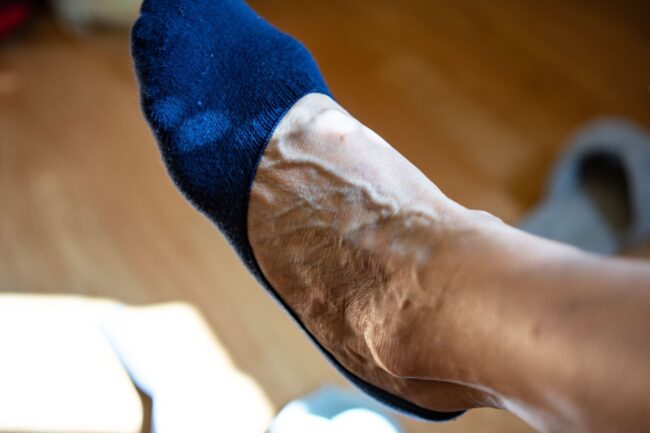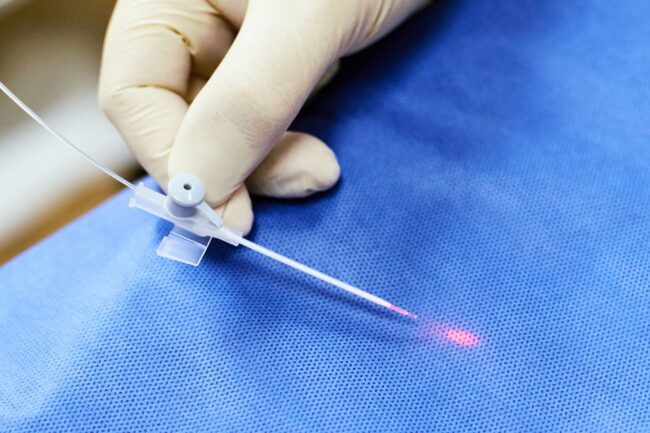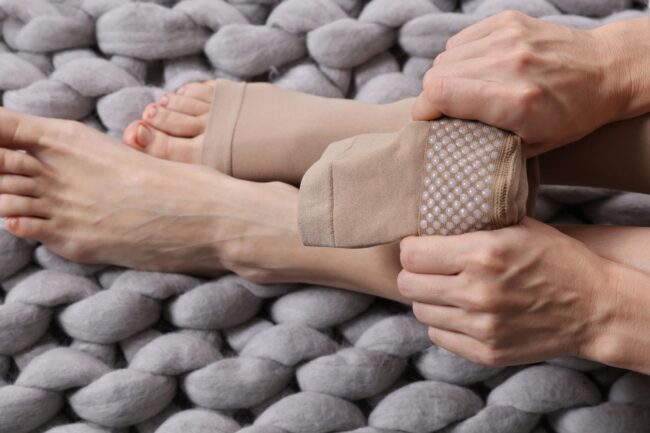Around 30% of Australians will get varicose veins at some point in their lives, and most of those cases will appear in the legs. However, varicose veins in the legs will also often result in varicose veins in the feet. So if you’ve developed this condition and are wondering how to get rid of it, here are the best treatments for varicose veins in feet.
What makes foot varicose veins different?

Varicose veins in the feet don’t often turn varicose on their own. Instead, they typically form due to chronic venous insufficiency (CVI) or varicose veins in the legs. CVI is essentially the condition that causes varicose veins. It’s a condition where vein valves malfunction and can no longer stop the backward flow of blood. And because your foot veins can no longer rely on your leg veins to move blood out, blood pools, pressure builds, and their walls stretch out and turn varicose.
As with leg veins, varicose foot veins can cause the following symptoms.
- Itching
- Swelling
- Redness
- A dull ache that gets worse at night
You will likely feel these in both the leg and the foot.
Learn more: Top Risk Factors for Chronic Venous Insufficiency
How do you treat varicose veins in feet?

Vein specialists don’t usually treat varicose veins in the feet initially. Instead, they’ll treat the leg veins they’re attached to first and then address the foot veins, owing to the sensitive region they’re in. Foot veins are close to deep veins and other sensitive structures, meaning the risk of treating them directly is higher. And if the foot veins are treated in isolation, there’s a chance that any underlying venous insufficiency in the leg will turn them varicose again.
When your vein doctor seals a leg vein, your blood will stop flowing through it from the foot vein. Your body will automatically reroute blood flow to nearby healthy veins and absorb the varicose one as well as all the veins relying on it to transport blood to the heart.
And don’t worry, you don’t need those veins for good circulation. Superficial veins are usually the ones to turn varicose, and they’re collectively only responsible for about 10% of your blood flow.
What’s the best treatment for varicose veins in feet?
There is no definitive ‘best’ treatment for varicose veins. As every case of the condition is different, your vein doctor will need to assess your veins to determine the best course of action for you. Treatments include:
Endovenous Laser Ablation (EVLA)
With a 98% success rate, this is considered a gold-standard treatment for varicose veins, though it’s not suitable for everyone. Best for large veins, varicose veins laser treatment involves making a tiny incision in the leg and feeding the EVLA laser fibre into the vein. Once inside, your vein doctor will turn on the laser to heat the vein walls and seal it shut for your body to absorb and re-route blood flow.
Radiofrequency Ablation (RFA)
Also a gold-standard procedure, RFA is very similar to EVLA. But instead of using a laser to heat the veins, your vein doctor will use short bursts of radiofrequency energy.
Medical Superglue
In a VenaSeal procedure, your doctor will inject cyanoacrylate (a medical glue) into the problem vein. Depending on the vein’s size, they may do so through a syringe or through the VenaSeal catheter. Once the glue is dispersed, your vein doctor will apply gentle pressure to glue the vein walls together, sealing it shut.
Sclerotherapy
During sclerotherapy, your vein doctor will inject sclerosant into the vein. It’s a solution designed to agitate the lining of the vein walls, causing them to shut. Unlike EVLA and RFA, sclerotherapy works best for smaller veins.
ClariVein
This procedure also uses a sclerosant. But instead of a series of syringe injections, your vein specialist will use the ClariVein catheter. This catheter has a 360-degree rotating tip that penetrates the vein wall while dispersing sclerosant, allowing specialists to cover more ground and making this procedure suitable for larger veins than what traditional sclerotherapy allows.
Varicose veins can also be treated through traditional surgical methods like vein stripping, ambulatory phlebectomy, transilluminated phlebectomy, and ligation. However, as surgical procedures are more invasive and involve removing the vein rather than sealing it, they often come with more risk and are only used in serious cases.
Are all treatments for varicose veins in feet medical?

Yes, medical intervention is the only way to get rid of varicose veins. However, there are some ways to relieve symptoms.
- Exercise. Physical activities like walking, yoga, and swimming are great ways to get some varicose vein pain relief. As low-impact sports that work the legs, they’ll help move blood out of overflowing veins without stressing your circulatory system.
- Compression socks. Medical-grade compression garments like socks and stockings will help in two key ways. First, they’ll squeeze blood out of overflowing surface veins and into the deep veins to be carried into the heart. And second, they’ll activate your foot and leg muscles even when you’re still, making them more efficient pumps for your veins.
- Elevate your legs. Your leg and foot veins have to work hard, fighting against the pull of gravity to move blood out of your extremities and into the heart. Propping your feet above heart level for a few minutes a day (especially if you’ve been standing or sitting a lot) will ease the pressure and help relieve symptoms.
- Moisturises and creams. If you feel like the varicose veins in your feet are itchy, you may be experiencing the start of varicose eczema. This condition turns the skin dry and flaky, making it itch. To alleviate this, try gently massaging in a hypoallergenic moisturiser, calamine lotion, or a specific eczema cream like Dermaveen. Speak to your dermatologist to determine the best option for you.
Seek specialist advice
If you’re experiencing varicose vein symptoms in the feet or legs, don’t hesitate to see a specialist. We at The Vein Institute have years of experience diagnosing and treating the condition, so we’d be happy to be part of your treatment journey. To book a consultation in our Sydney varicose vein clinic, call us on 0420 102 637 or request an appointment online.
